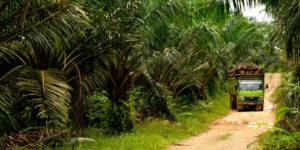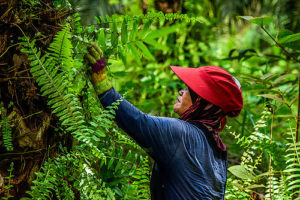
In 2014, many of the world’s major companies buying, trading or producing palm oil and pulp and paper made a joint commitment to stop clearing natural forests by 2020. As the deadline draws near, how are these ‘no deforestation’ commitments progressing, and what effect are they having on forests?
Using LANDSAT satellite data to observe annual changes in forest area and annual expansion of industrial plantations, scientists at the Center for International Forestry Research (CIFOR), including from the CGIAR Research Program on Forests, Trees and Agroforestry (FTA), are assessing the impact of corporate commitments to stop deforestation on the island of Borneo.
Borneo, a landmass shared by Indonesia, Malaysia and Brunei Darussalam, is home to some of the most diverse ecosystems on Earth. But forest fires and land conversion for logging, plantations and infrastructure development have reduced the island’s old-growth forest area by 30 percent since 1973.
Expansion of plantations for palm oil and pulp and paper has been associated with significant forest loss in Borneo, especially in Indonesia and Malaysia as the world’s leading producers of palm oil.
The ongoing research is looking at how pledges to stop this trend are having an effect, both inside and outside of plantation concession areas.
David Gaveau, co-creator of the newly updated Atlas of Deforestation and Industrial Plantations in Borneo, has been working on developing tools for buyers, traders, producers, governments and consumers to track industrial agriculture supply chains in Borneo, and monitor their impact on forests. He sat down with Forests News this week to discuss ongoing research, and what he and his partners have found so far.
What does it mean for a company to make a ‘No deforestation’ commitment?
When we talk about deforestation-free palm oil or paper, we are talking about products that have not been extracted from plantations established in place of forests. That is, where no forests have been cleared and converted to plantations. What this means in practice is that the products should come from plantations established on lands that have been cleared for other reasons, for example by wildfire, such as degraded shrublands.
A large number of palm oil and paper buyers and traders have already pledged to source only deforestation-free palm oil or paper, and in turn, the largest palm oil and pulp and paper producers have promised to stop clearing forests to expand plantations. Some made this pledge in 2013, with immediate effect. So in our research, we have sought to analyze whether those pledges, made with immediate effect, reduced overall rates of forest loss in Borneo.
Read more: New map helps track palm-oil supply chains in Borneo
Why are companies making ‘No deforestation’ commitments? Does it have any effect on profits?
Companies are making these commitments under pressure from consumer groups, environmental NGOs, and now even financial markets. For far too long, extractive industries made profit without respecting the environment. Times are changing.

How is a commitment monitored, and by whom?
Ideally, commitments should be monitored by tracking the palm oil back to the plantation where it was produced, and by verifying whether this plantation has been established at the expense of a forest, or whether it has replaced degraded, non-forested lands.
Have these pledges had an observable impact on deforestation rates in your research area in recent years?
Borneo is a major center for palm oil production. The area of industrial oil palm plantations in 2016 reached 8.3 million hectares — about half of the estimated global planted area of 18 million hectares. Old-growth forest area losses averaged 350,000 hectares annually from 2001 to 2016. By old-growth, we mean ancient forests that have never been impacted by humans, or forests impacted by timber extraction, but which have not been totally been cleared, and where the structure of a forest remains.
We showed in a paper published last year that the expansion of industrial oil palm plantations was responsible for 50 percent of all of Borneo’s old-growth forest area lost between 2005 to 2015. This number rises to 56 percent if we include pulpwood plantations. So, if producing companies stop clearing forests to expand plantations, deforestation should drop dramatically.
Our preliminary results from ongoing research suggest that recent corporate commitments to stop clearing forests in concessions of oil palm and pulpwood are associated with less conversion of forests to industrial plantations in Borneo, at least for oil palm and pulpwood.
We find that this company-driven deforestation peaked in concessions in 2009 and again in 2012, and has since been decreasing since 2012. In 2016, it had decelerated to 14-year low. This decreasing trend appears in Indonesian and Malaysian Borneo, and suggests that ‘No Deforestation’ commitments have slowed forest conversion within concessions in both countries. But that is not the whole story.
Despite this positive finding, the area of forest cleared since 2013 has in fact increased in Borneo. In Kalimantan — Indonesian Borneo — in particular, forests in 2016 were cleared at the fastest rate since 1997, with nearly 400,000 hectares lost that year. Much of this deforestation was caused by uncontrolled El Niño fires during late 2015, but appeared in 2016 satellite data because of cloud cover.
We find that much of this deforestation occurred outside concessions, and on peatlands, highlighting the urgent need to prevent peatland fires in the future, and to find solutions to deforestation outside concessions, where companies do not have jurisdiction. We also see a troubling trend in concessions where a lot of forest remains. In those forest-rich concessions, company-driven deforestation has not slowed, suggesting that ‘business as usual’ has continued in undeveloped concessions.
Read more: Financing farmers: Can funds for oil palm help save our forests?
How do you measure or observe the impact of commitments on forests?
We have mapped then analyzed the area of forest converted each year to industrial oil palm and pulpwood plantations from 2001 to 2016, looking mainly at land under company management – that is, concessions. We use LANDSAT satellite imagery to monitor the annual expansion of plantations.
We combine this information with annual maps of forest loss also derived using LANDSAT satellites by Matthew Hansen’s research group at the University of Maryland. The Hansen dataset, as we call it, produces very accurate tree loss maps over the humid tropics, and combined with a good forest mask, reveals where old-growth forests have been cleared. However, this dataset does not tell us why forest has been cleared, or who cleared it.
By combining our annual maps of plantations with this forest loss dataset, we can extract the area of forest converted each year to industrial plantations by producing companies. This is what we call company-driven deforestation.
What about the effect outside of concession areas, or in nearby forests?
Deforestation caused by fire is even more dramatic in Borneo outside concessions, where it recently jumped by 400 percent to a 16-year high in 2016.
What plans do you have for researching this further, and drawing recommendations for action?
We now aim to understand other drivers of deforestation in the Borneo landscape. For example, we are quantifying the impacts of forest fires, and smallholder and mining activity. We aim to equip governments, NGOS and companies with the capacity to see the full impact of the human enterprise on Borneo forests, and to act accordingly to bring the rate of forest loss down to zero.
By Catriona Croft-Cusworth, originally published at CIFOR’s Forests News.
For more information on this topic, please contact David Gaveau at d.gaveau@cgiar.org.
This research forms part of the CGIAR Research Program on Forests, Trees and Agroforestry, which is supported by CGIAR Fund Donors.
This research was supported by UK aid from the UK government and the United States Agency for International Development (USAID).











